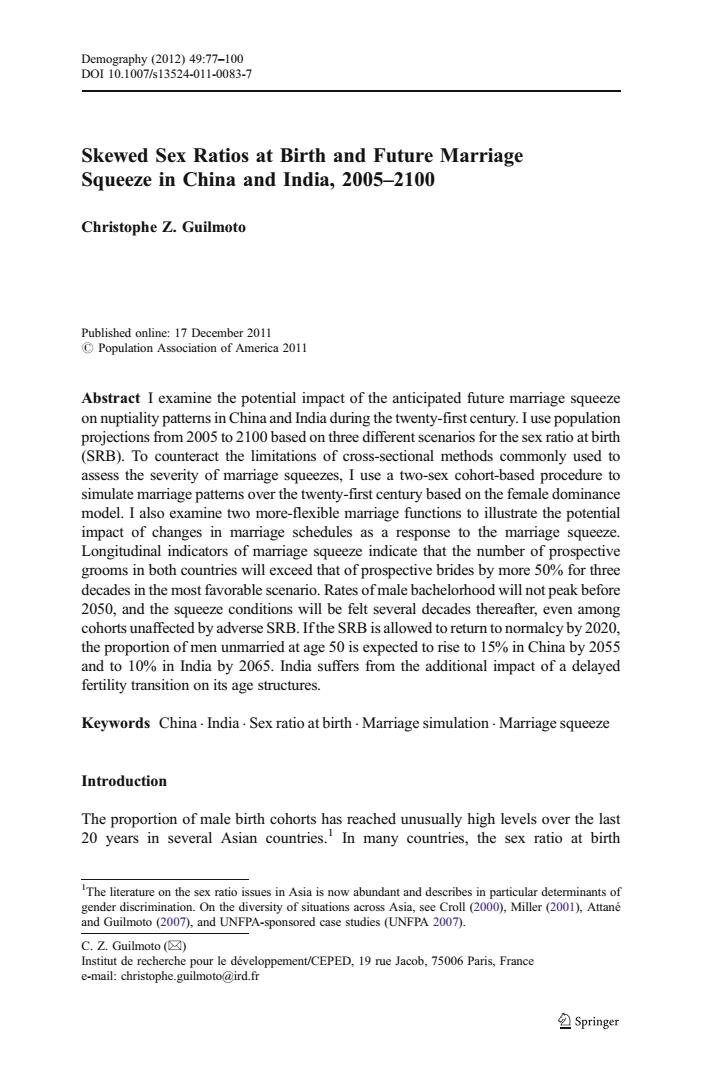正在加载图片...

Demography(2012)49:77-100 D0I10.1007/s13524-011-0083-7 Skewed Sex Ratios at Birth and Future Marriage Squeeze in China and India,2005-2100 Christophe Z.Guilmoto Published online:17 December 2011 C Population Association of America 2011 Abstract I examine the potential impact of the anticipated future marriage squeeze on nuptiality patterns in China and India during the twenty-first century.I use population projections from 2005 to 2100 based on three different scenarios for the sex ratio at birth (SRB).To counteract the limitations of cross-sectional methods commonly used to assess the severity of marriage squeezes,I use a two-sex cohort-based procedure to simulate marriage pattems over the twenty-first century based on the female dominance model.I also examine two more-flexible marriage functions to illustrate the potential impact of changes in marriage schedules as a response to the marriage squeeze. Longitudinal indicators of marriage squeeze indicate that the number of prospective grooms in both countries will exceed that of prospective brides by more 50%for three decades in the most favorable scenario.Rates of male bachelorhood will not peak before 2050,and the squeeze conditions will be felt several decades thereafter,even among cohorts unaffected by adverse SRB.Ifthe SRB is allowed to return to normalcy by 2020, the proportion of men unmarried at age 50 is expected to rise to 15%in China by 2055 and to 10%in India by 2065.India suffers from the additional impact of a delayed fertility transition on its age structures. Keywords China.India.Sex ratio at birth.Marriage simulation.Marriage squeeze Introduction The proportion of male birth cohorts has reached unusually high levels over the last 20 years in several Asian countries.'In many countries,the sex ratio at birth The literature on the sex ratio issues in Asia is now abundant and describes in particular determinants of gender discrimination.On the diversity of situations across Asia,see Croll(2000),Miller(2001),Attane and Guilmoto (2007),and UNFPA-sponsored case studies (UNFPA 2007). C.Z.Guilmoto(☒ Institut de recherche pour le developpement/CEPED,19 rue Jacob,75006 Paris,France e-mail:christophe.guilmoto @ird.fr ②SpringerSkewed Sex Ratios at Birth and Future Marriage Squeeze in China and India, 2005–2100 Christophe Z. Guilmoto Published online: 17 December 2011 # Population Association of America 2011 Abstract I examine the potential impact of the anticipated future marriage squeeze on nuptiality patterns in China and India during the twenty-first century. I use population projections from 2005 to 2100 based on three different scenarios for the sex ratio at birth (SRB). To counteract the limitations of cross-sectional methods commonly used to assess the severity of marriage squeezes, I use a two-sex cohort-based procedure to simulate marriage patterns over the twenty-first century based on the female dominance model. I also examine two more-flexible marriage functions to illustrate the potential impact of changes in marriage schedules as a response to the marriage squeeze. Longitudinal indicators of marriage squeeze indicate that the number of prospective grooms in both countries will exceed that of prospective brides by more 50% for three decades in the most favorable scenario. Rates of male bachelorhood will not peak before 2050, and the squeeze conditions will be felt several decades thereafter, even among cohorts unaffected by adverse SRB. If the SRB is allowed to return to normalcy by 2020, the proportion of men unmarried at age 50 is expected to rise to 15% in China by 2055 and to 10% in India by 2065. India suffers from the additional impact of a delayed fertility transition on its age structures. Keywords China . India . Sex ratio at birth . Marriage simulation . Marriage squeeze Introduction The proportion of male birth cohorts has reached unusually high levels over the last 20 years in several Asian countries.1 In many countries, the sex ratio at birth Demography (2012) 49:77–100 DOI 10.1007/s13524-011-0083-7 1 The literature on the sex ratio issues in Asia is now abundant and describes in particular determinants of gender discrimination. On the diversity of situations across Asia, see Croll (2000), Miller (2001), Attané and Guilmoto (2007), and UNFPA-sponsored case studies (UNFPA 2007). C. Z. Guilmoto (*) Institut de recherche pour le développement/CEPED, 19 rue Jacob, 75006 Paris, France e-mail: christophe.guilmoto@ird.fr